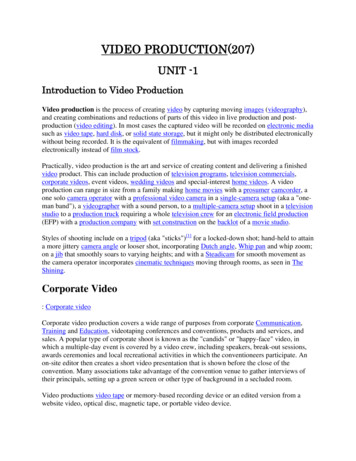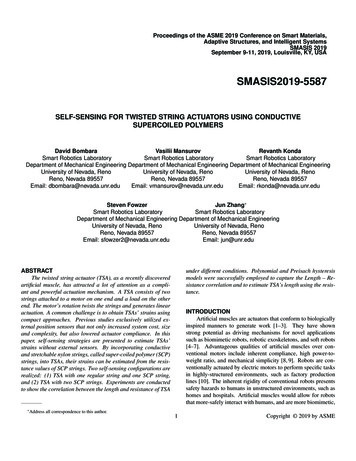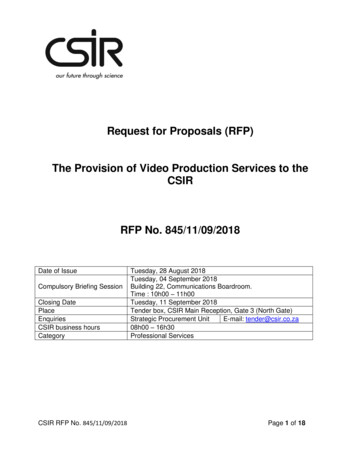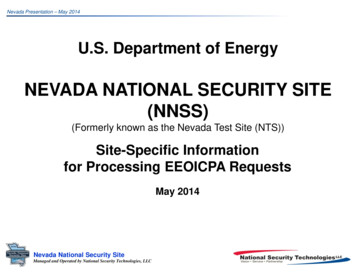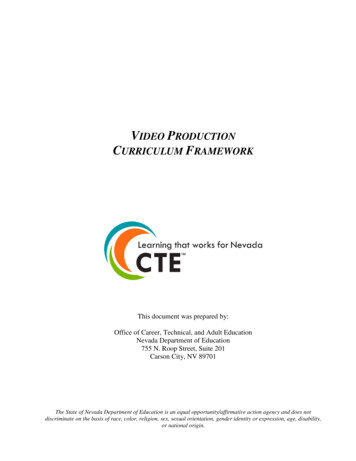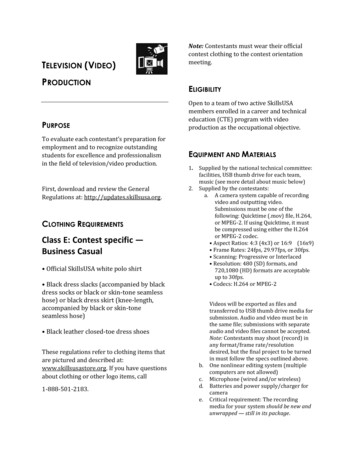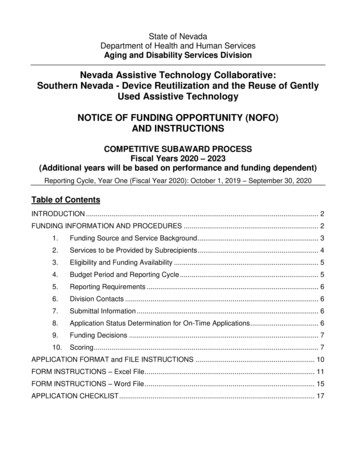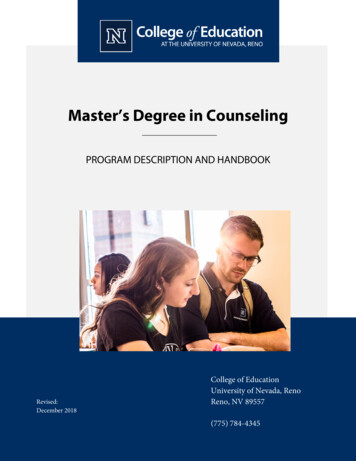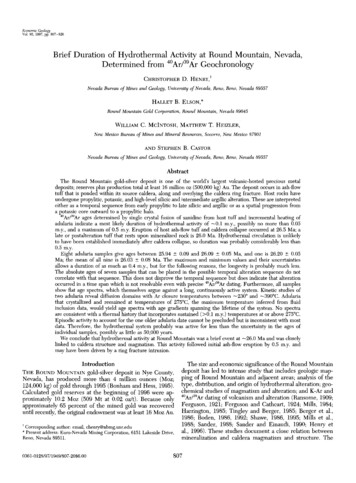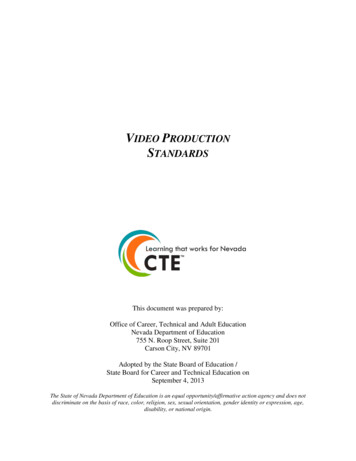
Transcription
VIDEO PRODUCTIONSTANDARDSThis document was prepared by:Office of Career, Technical and Adult EducationNevada Department of Education755 N. Roop Street, Suite 201Carson City, NV 89701Adopted by the State Board of Education /State Board for Career and Technical Education onSeptember 4, 2013The State of Nevada Department of Education is an equal opportunity/affirmative action agency and does notdiscriminate on the basis of race, color, religion, sex, sexual orientation, gender identity or expression, age,disability, or national origin.
VIDEO PRODUCTION STANDARDS2013NEVADA STATE BOARD OF EDUCATIONNEVADA STATE BOARD FOR CAREER AND TECHNICAL EDUCATIONElaine Wynn. PresidentAllison Serafin .Vice PresidentThad Ballard. MemberDave Cook . MemberStavan Corbett . MemberAlexis Gonzales-Black. MemberFreeman Holbrook . MemberKevin Melcher . MemberMark Newburn . MemberRichard Stokes . MemberKamryn Mock . Student RepresentativeCTE MISSION STATEMENT:The Office of Career, Technical and Adult Education is dedicated to developing innovativeeducational opportunities for students to acquire skills for productive employment and lifelong learning.NEVADA DEPARTMENT OF EDUCATIONDale A.R. ErquiagaSuperintendent of Public InstructionMichael J. Raponi, DirectorOffice of Career, Technical and Adult EducationRev: 09/04/2013Nevada CTE Standardsiii
VIDEO PRODUCTION STANDARDS2013TABLE OF CONTENTSNevada State Board of Education / Nevada Department of Education. iiiAcknowledgements / Standards Development Members / Business and Industry Validation /Project Coordinator . viiIntroduction . ixContent Standard 1.0 – Examine the Video Production Industry . 1Content Standard 2.0 – Safety and Personal Responsibility in the Workplace. 2Content Standard 3.0 – Demonstrate the Use of Video Production Equipment . 3Content Standard 4.0 – Writing for Video Production . 4Content Standard 5.0 – Demonstrate Industry Standard Production Practices . 5Content Standard 6.0 – Understand the Editing Process. 6Crosswalks and Alignments . 7Rev: 09/04/2013Nevada CTE Standardsv
VIDEO PRODUCTION STANDARDS2013ACKNOWLEDGEMENTSThe development of Nevada career and technical standards and assessments is a collaborative effortsponsored by the Office of Career, Technical and Adult Education at the Department of Education and theCareer and Technical Education Consortium of States. The Department of Education relies on teachersand industry representatives who have the technical expertise and teaching experience to developstandards and performance indicators that truly measure student skill attainment. Most important,however, is recognition of the time, expertise and great diligence provided by the writing team membersin developing the career and technical standards for Video Production.STANDARDS DEVELOPMENT MEMBERSMatt Mayhood, InstructorFoothill High School, HendersonMike Bowers, InstructorSpanish Springs High School, SparksTom Rizzo, InstructorSouthwest Career and Technical Academy, Las VegasRick Marks, ProfessorCollege of Southern Nevada, Las VegasVicki Steffenhagen, InstructorPalo Verde High School, Las VegasRobin Tanner, Tanner ProductionsBusiness and Industry Representative, RenoBrian Wells, ProfessorTruckee Meadows Community College, RenoCraig Musni, Washoe County School DistrictBusiness and Industry Representative, RenoMonique Gaudin, Clark County School DistrictBusiness and Industry Representative, Las VegasBUSINESS AND INDUSTRY VALIDATIONAll CTE standards developed through the Nevada Department of Education are validated by business andindustry through one or more of the following processes: (1) the standards are developed by a teamconsisting of business and industry representatives; or (2) a separate review panel was coordinated withindustry experts to ensure the standards include the proper content; or (3) the adoption of nationallyrecognized standards endorsed by business and industry.The Video Production standards were validated through active participation of business and industryrepresentatives on the development team.PROJECT COORDINATORSue Poland, Education Programs ProfessionalAgriculture EducationOffice of Career, Technical and Adult EducationNevada Department of EducationRev: 09/04/2013Nevada CTE Standardsvii
VIDEO PRODUCTION STANDARDS2013INTRODUCTIONThe standards in this document are designed to clearly state what the student should know and beable to do upon completion of an advanced high school Video Production program. These standards aredesigned for a three-credit course sequence that prepares the student for a technical assessment directlyaligned to the standards.These exit-level standards are designed for the student to complete all standards through theircompletion of a program of study. These standards are intended to guide curriculum objectives for aprogram of study.The standards are organized as follows:Content Standards are general statements that identify major areas of knowledge,understanding, and the skills students are expected to learn in key subject and career areas by the end ofthe program.Performance Standards follow each content standard. Performance standards identify the morespecific components of each content standard and define the expected abilities of students within eachcontent standard.Performance Indicators are very specific criteria statements for determining whether a studentmeets the performance standard. Performance indicators may also be used as learning outcomes, whichteachers can identify as they plan their program learning objectives.The crosswalk and alignment section of the document shows where the performance indicatorssupport the English Language Arts and the Mathematics Common Core State Standards, and the NevadaState Science Standards. Where correlation with an academic standard exists, students in the VideoProduction program perform learning activities that support, either directly or indirectly, achievement ofone or more Common Core State Standards.All students are encouraged to participate in the career and technical student organization (CTSO)that relates to their program area. CTSOs are co-curricular national associations that directly enforcelearning in the CTE classroom through curriculum resources, competitive events, and leadershipdevelopment. CTSOs provide students the ability to apply academic and technical knowledge, developcommunication and teamwork skills, and cultivate leadership skills to ensure college and career readiness.The Employability Skills for Career Readiness identify the “soft skills” needed to be successful inall careers, and must be taught as an integrated component of all CTE course sequences. These standardsare available in a separate document.The Standards Reference Code is only used to identify or align performance indicators listed inthe standards to daily lesson plans, curriculum documents, or national standards.Program NameVideo ProductionStandards Reference CodeVIDEOExample: VIDEO.2.3.4StandardsVideo ProductionRev: 09/04/2013Content Standard2Performance Standard3Nevada CTE StandardsPerformance Indicator4ix
VIDEO PRODUCTION STANDARDSCONTENT STANDARD 1.0 :2013EXAMINE THE VIDEO PRODUCTION INDUSTRYPERFORMANCE STANDARD 1.1 : RESEARCH EVENTS THAT LED TO CURRENT PRACTICES1.1.11.1.21.1.3Develop a timeline for major technological developments and events in the history of mediaExplain the importance of industry pioneers and significant moments in media historyAnalyze the influence of mass media on societyPERFORMANCE STANDARD 1.2 : INVESTIGATE INDUSTRY ETHICS AND LAWS1.2.11.2.21.2.31.2.41.2.51.2.61.2.71.2.8Define terms applicable to ethics and laws (e.g., plagiarism, copyright law, libel, slander, etc.)Discuss how to legally obtain and use source materials for production purposesExplain copyright laws/issues that pertain to video productionSummarize legal and ethical acquisition and use of digital materials, giving attribution usingestablished methodsResearch and follow Federal Communications Commission (FCC) regulationsDiscuss video and audio consents for assigned projectsDiscuss the First Amendment guarantees relating to video productionExplain proper attribution (citing) proceduresPERFORMANCE STANDARD 1.3 : EXPLAIN THE STAGES OF THE VIDEO PRODUCTION PROCESS1.3.11.3.21.3.31.3.41.3.5List the components of the pre-production phase (e.g., purpose, script writing, target audience,budget, schedule, script writing, output medium, etc.)Conduct a pre-production meeting to create a production planList the components of the production phase (e.g., selecting equipment, operating equipment,interviewing, directing, lighting, audio, etc.)List the components of the post-production phase (e.g., video and audio editing, graphics, outputmedium, etc.)List the steps in conducting a post-production meetingPERFORMANCE STANDARD 1.4 : INVESTIGATE THE VARIOUS ROLES IN VIDEO PRODUCTION1.4.11.4.2Summarize the roles of various personnel for video production projects (e.g., producer, director,editor, camera operator, etc.)Develop appropriate communication skills when working with clients, crew, and talentPERFORMANCE STANDARD 1.5 : EXPLORE CAREERS IN THE VIDEO INDUSTRY1.5.11.5.21.5.3Research occupations found within the video production industryCompare major organizations or institutions involved with the video production industryCreate a job description for a video production occupationRev: 09/04/2013Nevada CTE Standards1
2013VIDEO PRODUCTION STANDARDSCONTENT STANDARD 2.0 :SAFETY AND PERSONAL RESPONSIBILITY IN THEWORKPLACEPERFORMANCE STANDARD 2.1 : MAINTAIN AN ORDERLY AND SAFE WORK ENVIRONMENT2.1.12.1.22.1.32.1.4Identify and locate all safety equipment in media labs and on location (e.g., first aid kit, fireextinguisher, etc.)Discuss safety precautions and practicesDemonstrate the safe usage of appropriate tools and the proper operation of equipmentMaintain and troubleshoot tools and equipmentPERFORMANCE STANDARD 2.2 : DEMONSTRATE PERSONAL RESPONSIBILITY ANDPROFESSIONALISM2.2.12.2.22.2.32.2.42Exhibit professional conduct and work ethics in the development of productionsDiscuss appropriate responses to criticismDress professionally and appropriately as per assignmentExhibit the ability to follow directionsNevada CTE StandardsRev: 09/04/2013
VIDEO PRODUCTION STANDARDSCONTENT STANDARD 3.0 :2013DEMONSTRATE THE USE OF VIDEO PRODUCTIONEQUIPMENTPERFORMANCE STANDARD 3.1 : DEMONSTRATE CAMERA OPERATION AND Select, operate, and exhibit correct use of video cameras for project specificationsDemonstrate the functions and uses of camera mounting devices (e.g., tripods, steadicam, monopods,etc.)Demonstrate types of camera angles and movementsDemonstrate the rule of thirdsDemonstrate different shot compositions (e.g., medium shot, close up, long shot, etc.)Demonstrate shot flow including sequencing and continuityDemonstrate effective use of white balance settingsConnect various pieces of video equipment using the proper cables and/or adaptersPERFORMANCE STANDARD 3.2 : DEMONSTRATE THE USE OF AUDIO EQUIPMENT fy the types, uses, and pick-up patterns of various microphonesCompare and contrast the types, uses, and pick-up patterns of various microphonesDemonstrate proper placement of microphones for effective audioConnect microphone(s) to various audio equipment using the proper cables and/or adaptersRecord a short audio sequence, properly monitoring the sound levelIdentify and correct sources of interference and poor sound qualityDemonstrate the use of mixing multiple sources in live and post-production settingsPERFORMANCE STANDARD 3.3 : DEMONSTRATE PROPER LIGHTING TECHNIQUES3.3.13.3.23.3.33.3.4Identify and explain the use of basic lighting equipmentDemonstrate one, two and three point lighting techniquesUtilize various light sources (e.g., natural light, reflectors, portable lights, etc.)Explain and demonstrate the use of lighting techniques in creating composition, visual continuity,and moodPERFORMANCE STANDARD 3.4 : DEMONSTRATE EFFECTIVE USE OF VISUAL EFFECTS ANDCOMPUTER GRAPHICS3.4.13.4.23.4.33.4.4Use Chroma key techniques for compositing (e.g., green screen, virtual sets, weather maps, etc.)Discuss text, fonts, colors, title safe area, lower thirds, and placementEnhance a project using appropriate graphicsEnhance a project using appropriate visual effects (e.g., picture-in-picture, motion graphics, etc.)Rev: 09/04/2013Nevada CTE Standards3
2013VIDEO PRODUCTION STANDARDSCONTENT STANDARD 4.0 :WRITING FOR VIDEO PRODUCTIONPERFORMANCE STANDARD 4.1 : CONDUCT RESEARCH FOR PROJECTS4.1.14.1.24.1.34.1.44.1.54.1.6Identify potential biases when selecting intervieweesIdentify resources to conduct researchIdentify and utilize primary and secondary sourcesApply active research methods (e.g., critical reading, personal interviews, credible sources, use ofsurveys, etc.)Demonstrate effective note-taking skillsAttribute all sources correctlyPERFORMANCE STANDARD 4.2 : CREATE SCRIPTS AND STORYBOARDS4.2.14.2.24.2.34.2.44.2.54.2.6Determine appropriate script writing formats for various production types (e.g., news story,commercial, sports, PSA, narrative, etc.)Write stories that contain a logical beginning, middle, and endWrite scripts that convey a variety of desired story elements (e.g., leads, VO, SOT, VO/SOT, newspackage, etc.)Describe components of a two-column scriptExplain components of a storyboard (e.g., camera angles, locations, shots, movements, etc.)Translate from written scripts to storyboardsPERFORMANCE STANDARD 4.3 : DEVELOP INTERVIEWING elop open-ended questions to elicit in-depth responsesSelect interviewee(s) appropriate for the topicSelect a location that enhances the interviewContact interviewee(s) and schedule interview(s)Recognize the differences between biased and unbiased questions and answersAsk questions coherently and concisely, using proper grammarDemonstrate effective listening skillsImprovise questions based on the interviewee’s responsesNevada CTE StandardsRev: 09/04/2013
VIDEO PRODUCTION STANDARDSCONTENT STANDARD 5.0 :2013DEMONSTRATE INDUSTRY STANDARD PRODUCTIONPRACTICESPERFORMANCE STANDARD 5.1 : DEMONSTRATE APPROPRIATE ELECTRONIC FIELD PRODUCTION(EFP) PRACTICES5.1.15.1.25.1.35.1.45.1.5Evaluate possible shooting locations for a project (e.g., sound, lighting, environment, etc.)Perform field production jobs to include camera, lighting, and sound techniciansDemonstrate basic field camera operations to reflect each locationDetermine camera shooting techniques appropriate for the production, such as shot composition,angle, and use of mounting devicesCreate a project outside the studio using field equipment and techniquesPERFORMANCE STANDARD 5.2 : DEMONSTRATE APPROPRIATE STUDIO OPERATION5.2.15.2.25.2.35.2.45.2.55.2.6Demonstrate the setup and operation of basic studio equipment (e.g., switcher, teleprompter,recording unit, etc.) for specific project needsPerform the jobs necessary for a studio production (e.g., director, technical director (TD), audioengineer, recording/playback engineer, etc.)Demonstrate basic studio camera operationCreate and incorporate titles and other graphics in a studio productionUse proper studio lightingCreate a project inside the studio environmentPERFORMANCE STANDARD 5.3 : PERFORM ON-CAMERA5.3.15.3.25.3.35.3.45.3.55.3.6Demonstrate appropriate speaking skills for an on-camera performance (e.g., pitch, tone, emphasis,inflection, enunciation, timing, etc.)Practice appropriate on-camera performance skills (e.g., appearance, gestures, posture, etc.)Read for a camera using a teleprompter or cue cardsPerform as talent in a productionDeliver material without bias (voice inflection or gesture)Select clothing, makeup, and accessories appropriate for use on-camera in a specific productionRev: 09/04/2013Nevada CTE Standards5
2013VIDEO PRODUCTION STANDARDSCONTENT STANDARD 6.0 :UNDERSTAND THE EDITING PROCESSPERFORMANCE STANDARD 6.1 : UNDERSTAND FILE FORMATS AND DATA MANAGEMENT6.1.16.1.26.1.3Differentiate between digital video files, still images, and audio filesCreate, compress, and convert digital video files, still images, and audio files in various formats(e.g., MPEG, WMV, MOV, MP4, JPEG, AIFF, MP3, AVCHD, MTS, etc.)Explain the need for data managementPERFORMANCE STANDARD 6.2 : OPERATE SOFTWARE FOR DIGITAL anize and evaluate materials for editingCapture/import source materialsManipulate video (i.e., color, motion, filters, and transitions)Utilize visual techniques to enhance the final product (i.e., animation, and graphics)Use multiple audio sources to complete a project (e.g., sound effects, room tone, music, etc.)Adjust audio levels for single or multiple tracksUse audio to enhance a final productExport a project to appropriate mediaPERFORMANCE STANDARD 6.3 : UNDERSTAND THE PRINCIPLES OF EDITING6.3.16.3.26.3.36.3.46.3.5Explain the impact of editing on continuityExplain the impact of editing on performanceExplain the impact of editing on emphasisExplain the impact of pacingApply the principles of editing to a production projectPERFORMANCE STANDARD 6.4 : EVALUATE THE PROJECT6.4.16.4.26.4.36Evaluate content for message effectiveness and bias (i.e., does it tell the complete story?)Assess video/audio quality for levels and clarityRevise work based on critiquesNevada CTE StandardsRev: 09/04/2013
VIDEO PRODUCTION STANDARDS2013CROSSWALKS AND ALIGNMENTS OFVIDEO PRODUCTION STANDARDSAND THE COMMON CORE STATE STANDARDS,THE NEVADA SCIENCE STANDARDS,AND THE COMMON CAREER TECHNICAL CORE STANDARDSCROSSWALKS (ACADEMIC STANDARDS)The crosswalk of the Video Production Standards shows links to the Common Core State Standardsfor English Language Arts and Mathematics and the Nevada Science Standards. The crosswalkidentifies the performance indicators in which the learning objectives in the Video Productionprogram support academic learning. The performance indicators are grouped according to theircontent standard and are crosswalked to the English Language Arts and Mathematics Common CoreState Standards and the Nevada Science Standards.ALIGNMENTS (MATHEMATICAL PRACTICES)In addition to correlation with the Common Core Mathematics Content Standards, many performanceindicators support the Common Core Mathematical Practices. The following table illustrates thealignment of the Video Production Standards Performance Indicators and the Common CoreMathematical Practices. This alignment identifies the performance indicators in which the learningobjectives in the Video Production program support academic learning.CROSSWALKS (COMMON CAREER TECHNICAL CORE)The crosswalk of the Video Production Standards shows links to the Common Career Technical Core.The crosswalk identifies the performance indicators in which the learning objectives in the VideoProduction program support the Common Career Technical Core. The Common Career TechnicalCore defines what students should know and be able to do after completing instruction in a programof study. The Video Production Standards are crosswalked to the Arts, A/V Technology &Communications Career Cluster and the A/V Technology & Film and Journalism and BroadcastingCareer Pathways.Rev: 09/04/2013Nevada CTE Standards7
2013VIDEO PRODUCTION STANDARDSThis Page was Intentionally Left Blank8Nevada CTE StandardsRev: 09/04/2013
VIDEO PRODUCTION STANDARDS2013CROSSWALK OF VIDEO PRODUCTION STANDARDSAND THE COMMON CORE STATE STANDARDSCONTENT STANDARD 1.0: EXAMINE THE VIDEO PRODUCTION .2.31.2.41.2.5Common Core State Standards and Nevada Science StandardsEnglish Language Arts: Reading Standards for Literacy in Science and Technical SubjectsRST.11-12.9Synthesize information from a range of sources (e.g., texts, experiments, simulations)into a coherent understanding of a process, phenomenon, or concept, resolvingconflicting information when possible.English Language Arts: Writing Standards for Literacy in Science and Technical SubjectsWHST.11-12.8 Gather relevant information from multiple authoritative print and digital sources, usingadvanced searches effectively; assess the strengths and limitations of each source interms of the specific task, purpose, and audience; integrate information into the textselectively to maintain the flow of ideas, avoiding plagiarism and overreliance on anyone source and following a standard format for citation.English Language Arts: Reading Standards for Literacy in Science and Technical SubjectsRST.11-12.7Integrate and evaluate multiple sources of information presented in diverse formats andmedia (e.g., quantitative data, video, multimedia) in order to address a question or solvea problem.English Language Arts: Writing Standards for Literacy in Science and Technical SubjectsWHST.11-12.8 Gather relevant information from multiple authoritative print and digital sources, usingadvanced searches effectively; assess the strengths and limitations of each source interms of the specific task, purpose, and audience; integrate information into the textselectively to maintain the flow of ideas, avoiding plagiarism and overreliance on anyone source and following a standard format for citation.English Language Arts: Speaking and Listening StandardsSL.11-12.2Integrate multiple sources of information presented in diverse formats and media (e.g.,visually, quantitatively, orally) in order to make informed decisions and solveproblems, evaluating the credibility and accuracy of each source and noting anydiscrepancies among the data.English Language Arts: Reading Standards for Literacy in Science and Technical SubjectsRST.11-12.9Synthesize information from a range of sources (e.g., texts, experiments, simulations)into a coherent understanding of a process, phenomenon, or concept, resolvingconflicting information when possible.English Language Arts: Reading Standards for Literacy in Science and Technical SubjectsRST.11-12.9Synthesize information from a range of sources (e.g., texts, experiments, simulations)into a coherent understanding of a process, phenomenon, or concept, resolvingconflicting information when possible.English Language Arts: Writing Standards for Literacy in Science and Technical SubjectsWHST.11-12.8 Gather relevant information from multiple authoritative print and digital sources, usingadvanced searches effectively; assess the strengths and limitations of each source interms of the specific task, purpose, and audience; integrate information into the textselectively to maintain the flow of ideas, avoiding plagiarism and overreliance on anyone source and following a standard format for citation.English Language Arts: Writing Standards for Literacy in Science and Technical SubjectsWHST.11-12.7 Conduct short as well as more sustained research projects to answer a question(including a self-generated question) or solve a problem; narrow or broaden the inquirywhen appropriate; synthesize multiple sources on the subject, demonstratingunderstanding of the subject under investigation.Rev: 09/04/2013Nevada CTE Standards9
20131.2.7VIDEO PRODUCTION STANDARDSEnglish Language Arts: Speaking and Listening StandardsSL.11-12.2Integrate multiple sources of information presented in diverse formats and media (e.g.,visually, quantitatively, orally) in order to make informed decisions and solveproblems, evaluating the credibility and accuracy of each source and noting anydiscrepancies among the data.SL.11-12.41.2.81.3.21.4.11.5.11.5.210Present information, findings, and supporting evidence, conveying a clear and distinctperspective, such that listeners can follow the line of reasoning, alternative or opposingperspectives are addressed, and the organization, development, substance, and style areappropriate to purpose, audience, and a range of formal and informal tasks.English Language Arts: Writing Standards for Literacy in Science and Technical SubjectsWHST.11-12.8 Gather relevant information from multiple authoritative print and digital sources, usingadvanced searches effectively; assess the strengths and limitations of each source interms of the specific task, purpose, and audience; integrate information into the textselectively to maintain the flow of ideas, avoiding plagiarism and overreliance on anyone source and following a standard format for citation.English Language Arts: Speaking and Listening StandardsSL.11-12.1bWork with peers to promote civil, democratic discussions and decision-making, setclear goals and deadlines, and establish individual roles as needed.English Language Arts: Reading Standards for Literacy in Science and Technical SubjectsRST.11-12.3Follow precisely a complex multistep procedure when carrying out experiments, takingmeasurements, or performing technical tasks; analyze the specific results based onexplanations in the text.English Language Arts: Writing Standards for Literacy in Science and Technical SubjectsWHST.11-12.8 Gather relevant information from multiple authoritative print and digital sources, usingadvanced searches effectively; assess the strengths and limitations of each source interms of the specific task, purpose, and audience; integrate information into the textselectively to maintain the flow of ideas, avoiding plagiarism and overreliance on anyone source and following a standard format for citation.English Language Arts: Writing Standards for Literacy in Science and Technical SubjectsWHST.11-12.7 Conduct short as well as more sustained research projects to answer a question(including a self-generated question) or solve a problem; narrow or broaden the inquirywhen appropriate; synthesize multiple sources on the subject, demonstratingunderstanding of the subject under investigation.English Language Arts: Writing Standards for Literacy in Science and Technical SubjectsWHST.11-12.8 Gather relevant information from multiple authoritative print and digital sources, usingadvanced searches effectively; assess the strengths and limitations of each source interms of the specific task, purpose, and audience; integrate information into the textselectively to maintain the flow of ideas, avoiding plagiarism and overreliance on anyone source and following a standard format for citation.Nevada CTE StandardsRev: 09/04/2013
VIDEO PRODUCTION STANDARDS2013CONTENT STANDARD 2.0: SAFETY AND PERSONAL RESPONSIBILITY IN THE WORKPLACEPerformanceIndicators2.2.2Common Core State Standards and Nevada Science StandardsEnglish Language Arts: Speaking and Listening StandardsSL.11-12.2Integrate multiple sources of information presented in diverse formats and media (e.g.,visually, quantitatively, orally) in order to make informed decisions and solveproblems, evaluating the credibility and accuracy of each source and noting anydiscrepancies among the data.SL.11-12.4Rev: 09/04/2013Present information, findings, and supporting evidence, conveying a clear and distinctperspective, such that listeners can follow the line of reasoning, alternative or opposingperspectives are addressed, and the organization, development, substance, and style areappropriate to purpose, audience, and a range of formal and informal tasks.Nevada CTE Standards11
2013VIDEO PRODUCTION STANDARDSCONTENT STANDARD 3.0: DEMONSTRATE THE USE OF VIDEO PRODUCTION 3.3.33.4.212Common Core State Standards and Nevada Science StandardsEnglish Language Arts: Reading Standards for Literacy in Science and Technical SubjectsRST.11-12.3Follow precisely a complex multistep procedure when carrying out experiments, takingmeasurements, or performing technical tasks; analyze the specific results based onexplanations in the textEnglish Language Arts: Reading Standards for Literacy in Science and Technical SubjectsRST.11-12.9Synthesize information from a range of sources (e.g., texts, experiments, simulations)into a coherent understanding of a process, phenomenon, or concept, resolvingconflicting information when possible.English Language Arts: Writing Standards for Literacy in Science and Technical SubjectsWHST.11-12.8 Gather relevant information from multiple authoritative print and digital sources, usingadvanced searches effectively; assess the strengths and limitations of each source interms of the specific task, purpose, and audience; integrate information into the textselectively to maintain the flow of ideas, avoiding plagiarism and overreliance on anyone source
1.5.1 Research occupations found within the video production industry 1.5.2 Compare major organizations or institutions involved with the video production industry 1.5.3 Create a job description for a video production occupation
